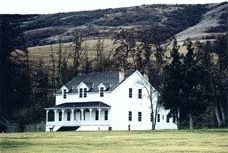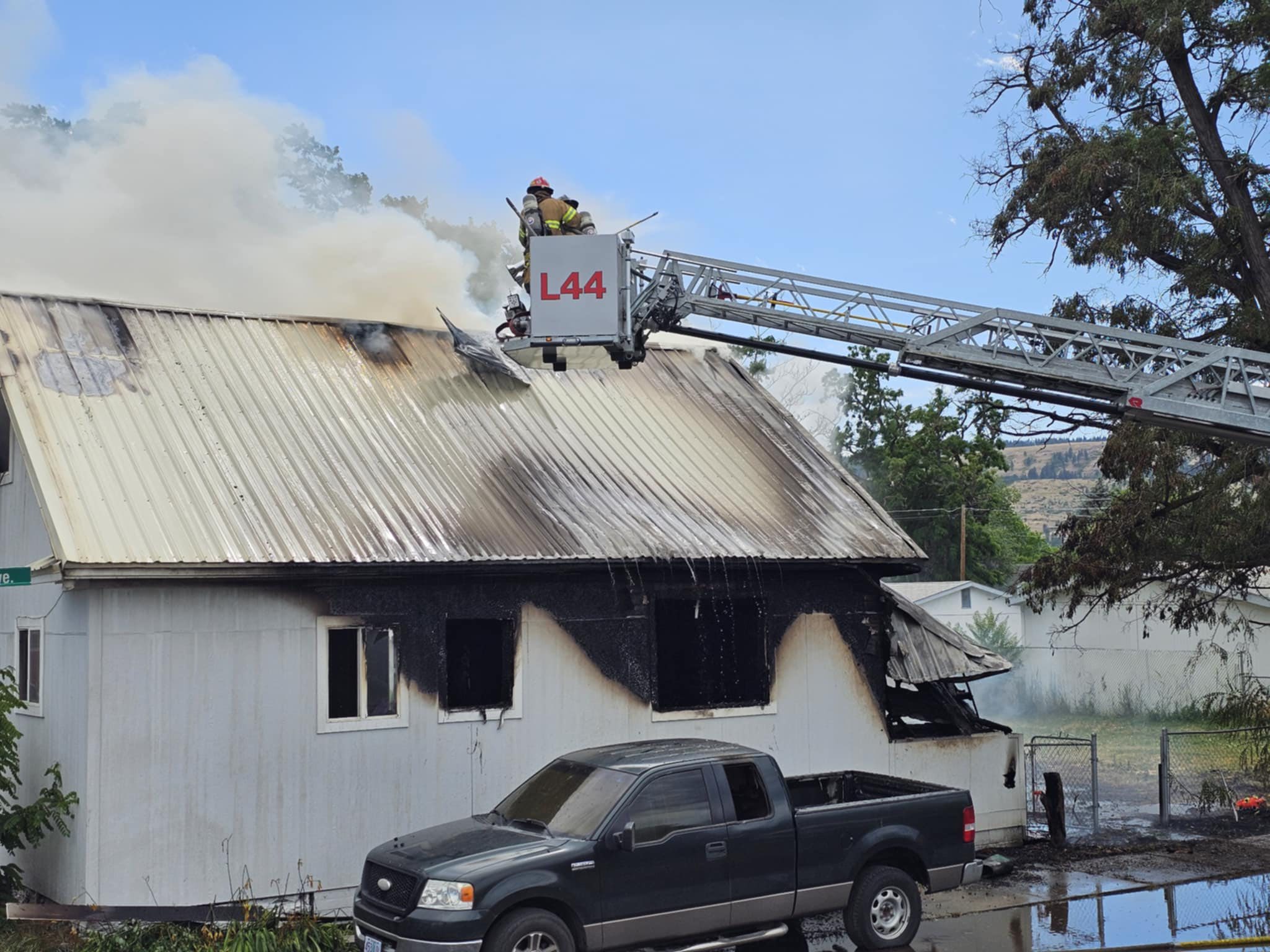STEEPED IN HISTORY
Published 12:00 am Friday, December 19, 2003

- OFFICER'S QUARTERS: The first troops engaged in the 1877 Nez Perce War marched from Fort Lapwai, built in 1862. The officer's quarters, the only building still standing, was built in 1883, a year before the fort closed. (Photos/MARK HIGHBERGER).
By Mark Highberger
For The Observer
Along a two-lane highway in western Idaho, only four miles separate two of the most influential periods in Northwest history. At one end of this stretch, missionaries at the Spalding Mission labored to win native souls; at the other, soldiers from Fort Lapwai fought to defeat Nez Perce warriors. Even though they occurred four decades apart, both battles initially failed.
Today these two sites are part of the Nez Perce National Historical Park, part of a pathway back to a time that has become as much legend as history.
Spalding Site
A six month journey in 1836 took Henry and Eliza Spalding, along with fellow missionaries Marcus and Narcissa Whitman, from the east coast to the Oregon Country. The Spaldings settled among the age-old villages of Nez Perce country on Lapwai Creek, two miles upstream from the river the Nez Perce called Kooskooskia and the whites named the Clearwater.
andamp;quot;It is on a little stream emptying into Koos Koos from the south,andamp;quot; Spalding wrote of his new home. andamp;quot;The Indians could scarcely contain themselves for joy when they heard us pronounce the word good.andamp;quot; This was the first Lapwai Mission. (Lapwai evolved from the Nez Perce name for the creek: thlep-thlep, said to be their word for the flapping of the wings of butterflies, which once swarmed the creek’s muddy banks.)
The Spaldings, however, found the heat and the mosquitoes troublesome, so after two years they moved downstream to the mouth of the creek. This was the second Lapwai Mission, the site that is today called Spalding. It was here that Henry and Eliza were responsible for a number of Idaho firsts. They not only were the first white family and had the first white child, but also introduced the first mills, printing, and written language.
But to understand how the mission fit into a long-ago place and time, head up the hill to the National Park’s visitor center, whose museum is a testament to Nez Perce culture. On display here are Nez Perce artifacts ranging from shirts to saddles, quirts to cradleboards, baskets to bearskins. This collection actually began with Henry Spalding, who started trading for them soon after he arrived.
andamp;quot;It is no easy matter to obtain these things from the natives,andamp;quot; he wrote, andamp;quot;as they always want to extort a great price as soon as they find I want them.andamp;quot;
Spalding sent his collection to Dudley Allen, an Ohio physician who had befriended the Spaldings by sending them andamp;quot;missionary barrels,andamp;quot; which contained clothing, tools, bedding, and other items that helped stretch the $500 annual expenditure the Mission Board permitted each missionary family.
andamp;quot;I want more,andamp;quot; Allen wrote Spalding about the collection. andamp;quot;They are all worth the having!!andamp;quot;
Evidently, others felt the same way, for the collection made its way first from Dr. Allen to Oberlin College, then to the Ohio Historical Society. It wasn’t until the early 1990s, when the Society asked for its return, that the Nez Perce and the National Park Service began a campaign to make the artifacts a permanent display. Their work paid off, for in 1996, a century and a half after Spalding shipped them off, the collection came home again to stay.
As far as Spalding’s own home is concerned, down the hill among the birch and locust trees you’ll find little left of the old missionthe symbolic hearth of the family cabin, the scarred traces of mill ponds and ditches. In fact, none of the original buildings remain, though numerous interpretive signs give you a sense of how it was before it all came to an end with the Whitman Massacre of 1847.
Soon after the massacre, some Nez Perce looted the Lapwai mission and held the Spaldings hostage for almost a month. After their rescue, Henry and Eliza moved to the Willamette Valley. Behind them lay the end of the mission era; in front of them, the beginning of the Cayuse War and the coming of the treaties that would convert native lands to homesteads and mines.
It was one of those treaties in 1855 that created the Nez Perce Reservation and gave the old mission site new life, this time as an Indian Agency. On the grounds today are a few of its remaining buildings: a single cabin, the agent’s house, and the Presbyterian church.
One area holding memories of both the mission and the agency is the nearby cemetery. The Spaldings are buried here; so is John Monteith, the Indian Agent during the time of Chief Joseph; and so is Josiah Red Wolf, the last Nez Perce survivor of the 1877 war. And up the highway just four miles away is one of the crucibles where that war had its beginnings.
Fort Lapwai
When gold was discovered in the Bitterroot Mountains in 1860, miners and settlers invaded Nez Perce land. To keep the peace, the army built Fort Lapwai in 1862. This far-flung post played a critical role in keeping that peace for 15 years, and in waging war when it finally broke.
Surrounding the parade grounds back then were quarters for officers and laundresses, barracks for cavalry and infantry, storehouses for the quartermaster and commissary, a trader’s store and a guard house. Today, however, you’ll find only the parade grounds and a single buildingthe officer’s quarters built in 1883, a year before the fort closed. Yet this place is about more than just buildings.
Onto these grounds in the days preceding the 1877 war rode the greatest Nez Perce chiefs of their day: Looking Glass of the Kooskia band, White Bird of the Upper Salmon, Toohoolhoolzote of the Lower Salmon, Joseph and Ollokot of the Wallowa.
General Oliver Otis Howard, who would lead the U.S. Army’s campaign against the Nez Perce, watched the Wallowa band ride in to the fort for a final meeting before the army sent them to the reservation. He described the procession as andamp;quot;a long rank of men, followed by women and children?andamp;quot; And they were singing.
The song, Howard said, was andamp;quot;wild and shrill and fierce, yet so plaintive at times it was almost like weeping, and made us sorry for them, although we could not but be glad that there were not five hundred instead of fifty.andamp;quot;
But Howard did not stay glad for long. When the war broke out, the first troops to engage the Nez Perce in combat were two companies that Howard sent from Fort Lapwai to Whitebird Canyon. On that battlefield, the army lost 34 men; the Nez Perce, none.
Soon after the war ended, the fort closed. That closing meant the eventual end of the mission site, which had grown into the town of Spalding. When the agency moved to the empty fort in 1904, the town withered, then died.
So for the villages, the mission, the fort, and the town, the most important thing left behind is a park that preserves the memories and the culture of a dramatic past.









